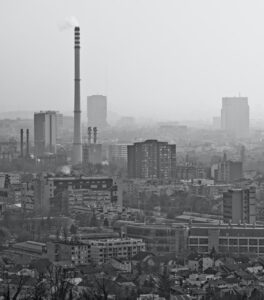SOHAM GUHA
“It looked like the great heat wave would be like mass shootings in the United States— mourned by all, deplored by all, and then immediately forgotten or superseded by the next one, until they came in a daily drumbeat and became the new normal.”
The aforementioned passage is not taken from any news report or radio broadcast, despite the familiarity imbued in every sentence. These words echo inside our skulls. When we aren’t busy tracking news that does not include politics or movie stars, we seen the collapse of civilization broadcasted live before our very eyes. Intellectuals and specialists alike had blamed the procedural and rampant deforestation across the nation, from cutting down trees to expand the Jessore Road to clearing of the mangroves for Bullet train tracks between Mumbai and Ahmedabad, to the scars called palm oil harvesting in Indonesia to massive ranches in the heart of amazon. Only last month, a monstrous heat wave had swept most of Northern India, clawing its way even to the riverine and humid West Bengal. The environmentalists have come to the roads of every metropolis across the globe and yelled, “We don’t inherit this world from our ancestors, we borrow it from our children.”
But are we listening to these murmurs of a few? Also, importantly this is the problem of people who are yet to be born. Why should we worry?
As Carl Sagan said:
“Looking at the image Voyager I sent from 6 billion kilometers away, looking back at a mote suspended in perpetual sunlight…There is perhaps no better demonstration of the folly of human conceits than this distant image of our tiny world. To me, it underscores our responsibility to deal more kindly with one another, and to preserve and cherish the pale blue dot, the only home we’ve ever known.” (Sagan, 2011)
In this regard, to make us humble and understanding, climate fiction comes as a subgenre of science fiction to deal with the uncertainty and atrocities imposed by climate change. The common tropes, or themes in a broader sense, climate fiction attempts to undertake and encompass a reflective, a variety of possible futures, and uncertainty. Each of these themes envisions a future that is ruled by characteristics of the global climate that is either perceived as a threat, or a topic of debate, and establishes connections that travel through time as facets of temporal and spatial strings. As these works appear as fiction, and not as elaborate academic articles, they embody the possibility of creating closer relationships with the reader and developing introspections to facilitate a proper shared picture of the future. A sustainable future.
As climate fiction:
“creates psychologically immersive and visceral experiences of possible futures – including dystopic ones resulting from inaction and utopic ones resulting from systemic change”
- (Constantino & Weber, 2021, p. 155)
it should be considered as a separate body of literature as well – with works ranging from post apocalyptic (Oryx and Crake – Atwood, 2003), utopian, dystopian (The Windup Girl – Bacigalupi, 2009), cyberpunk, to narratives heavily based on realism (Flight Behaviour – Kingsolver, 2012).
The psychological assumption is that climate change is a matter of worry for future generations, and therefore an individual in many ways constructs self-imposed boundaries related to time, space, socio-politico-economic dynamism, and thereby constructs abstractness regarding the gravity of the situation and consequences that follow. From personal experiences, dear reader, you have witnessed how every nation has tackled the prospect of another novel situation such as the coronavirus pandemic, and how we have reacted as individuals, creating reflective accounts of pandemic tales. The main issue that orchestrates this abstractedness stems from the tendency to perceive a situation as distant, either spatially or temporally, thinking it is too far away to affect one. For example, the scarcity of water in Cape Town, or Chennai for that matter, is a manifestation of shifting of local norms due to anthropogenic actions. A parameter to contribute to climate change and human migration. Finding potable water, coming out of the tap every morning and evening is so normal an occurrence that we seldom pay attention to the possibility of its absence and societies collapse from within when it does. Yet, time and again, it is witnessed that the wastage of drinkable water has become more severe in recent decades despite its increasing shortage. Stoknes (2014) has coined it as the Psychological Climate Paradox. The prospects for increasing clarity in people’s thinking are inherently complicated due to the intricate nature of the underlying systems of climate change. In a psycho-sociological context, researchers discovered that a smaller psychological distance from climate change was connected with more worry among the nearly affected population, which resulted in the desire to behave more responsibly and sustainably. In this regard, Milkoreit’s Theory of Imagination (2017) becomes a possibility to consider. Theory of Imagination emphasises upon the shared and collective imagination of individuals and society to enforce mitigating procedures for climate change, a very bottom-up approach in sociological experiments (Toivonen, 2022). This creation of shared instrumental value should act as an awareness buffer for educating people that the future is as uncertain as it is full of possibilities, and that there is an infinite number of future timelines to become realities based on our actions taken today based on beliefs, projections, imaginations of assumptions on both individualistic and societal levels.
However, little has been conducted in the academic sphere to study the effect of climate fiction, or cli-fi in colloquial tongue, and how it changes a reader’s perception of the future. The lack of qualitative research to produce an intricate and holistic interpretation of the reader’s awareness and encouragement to detail as possible has made the importance of climate fiction somewhat murky, despite the presence of critically acclaimed pieces of global literature in this subgenre.
Climate fiction is a multidisciplinary approach towards creating awareness, combining dry scientific facts with deep and diverse philosophical interpretations and plausible future worlds with believable characters. Thus, not only it makes the bleak prospect of an uncertain and grim future more approachable and accessible to a broader segment of people, but also increases the frequency of the generation awareness among them, according to the theory of availability bias (Tversky & Kahneman, 1973). One such book that depicts many futures is a prime paradigm of this theory, called The Overstory by Richard Powers. Published in 2018, this novel illustrates multiple futures through imbued drama, character development, highs and troughs of situations, interpretation of fear and hope, interwoven plotlines, and a vast coffer of diverse characters. With this novel, Powers not only makes his climate fiction novel a believable narrative, but a personal narrative as well.
It is human nature – the product of our upbringing and involvement of many archaic societal norms, that we cannot imagine or believe in a collective future, or a socialist future at that. This lack of imagination not only sets a myopic list of parameters for ourselves but also generates boundaries for the generations to come. Climate fictions are narratives acting as personal and emotional reminders, pushing readers from resistance to reluctance, to acceptance, that this Pale Blue Dot is where we must make a stand.
References
Constantino, S.M. and Weber, E.U., 2021. Decision-making under the deep uncertainty of climate change: The psychological and political agency of narratives. Current opinion in psychology, 42, pp.151-159.
Sagan, C. and Druyan, A., 2011. Pale blue dot: A vision of the human future in space. Ballantine books.
Stoknes, P.E., 2014. Rethinking climate communications and the “psychological climate paradox”. Energy Research & Social Science, 1, pp.161-170.
Milkoreit, M., 2017. Imaginary politics: Climate change and making the future. Elementa: Science of the Anthropocene, 5.
Toivonen, H., 2022. Themes of climate change agency: a qualitative study on how people construct agency in relation to climate change. Humanities and Social Sciences Communications, 9(1).
Tversky, A. and Kahneman, D., 1973. Availability: A heuristic for judging frequency and probability. Cognitive psychology, 5(2), pp.207-232.
Also, read Three Body Problem, a book review by Soham Guha and published in The Antonym:
Follow The Antonym’s Facebook page and Instagram account for more content and exciting updates.



























0 Comments